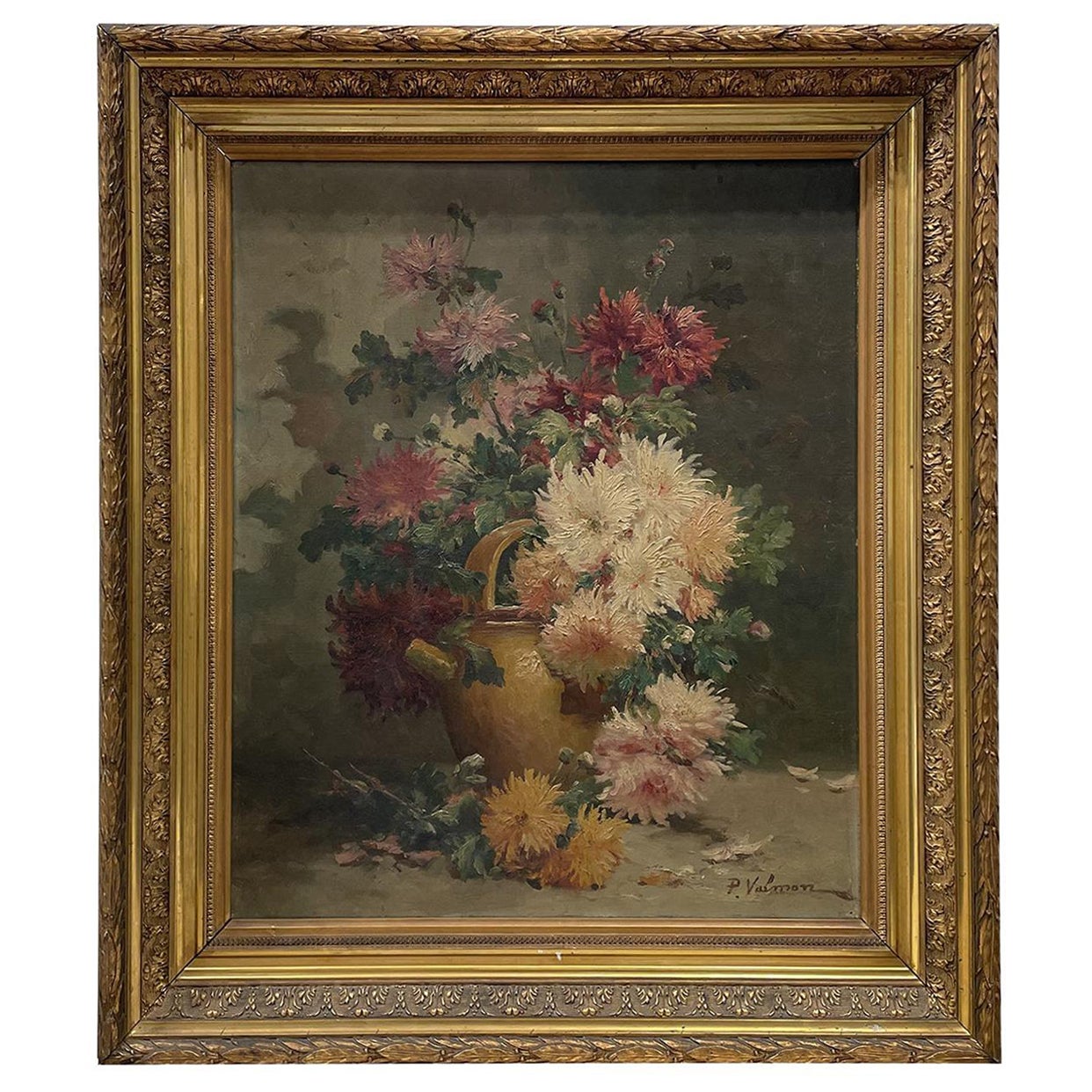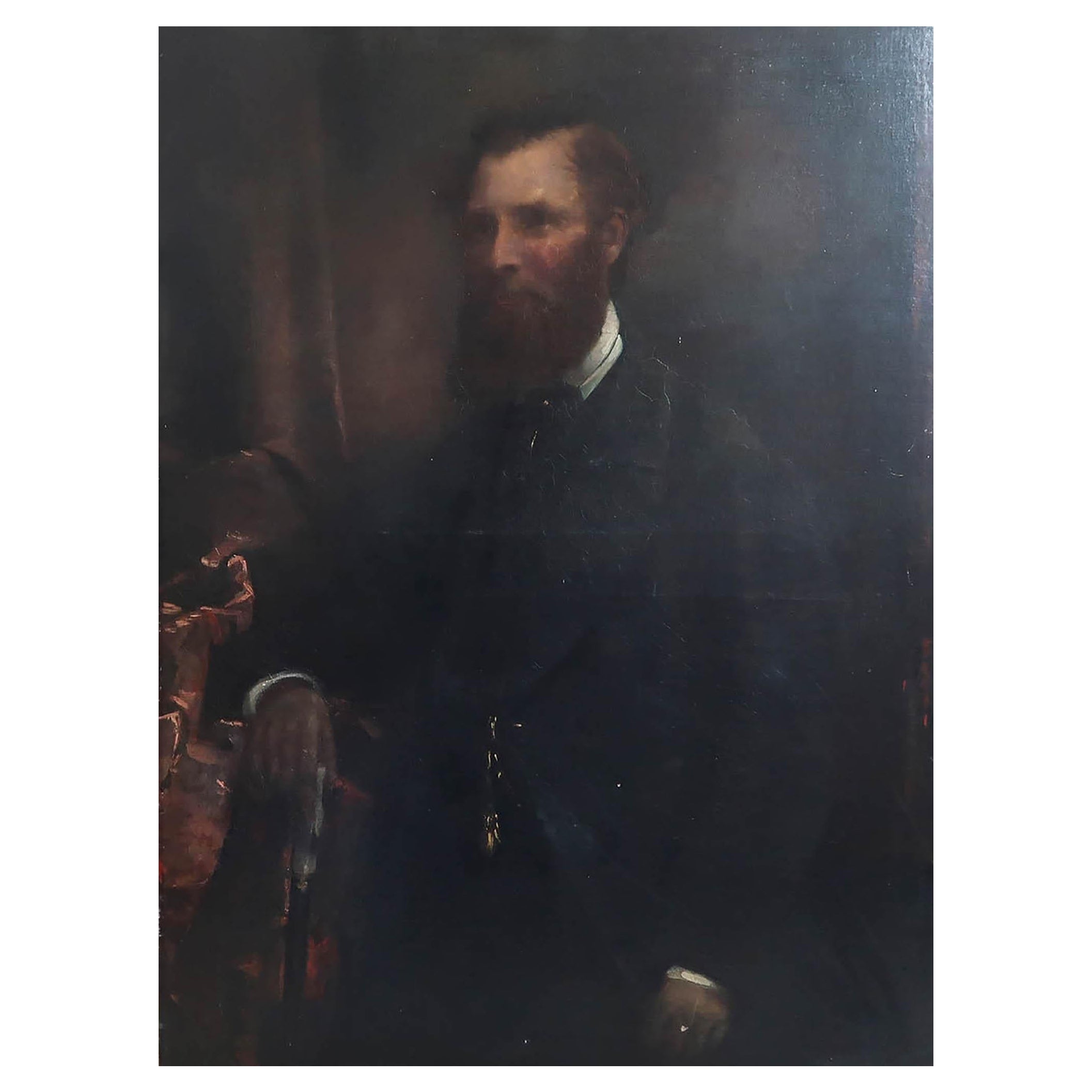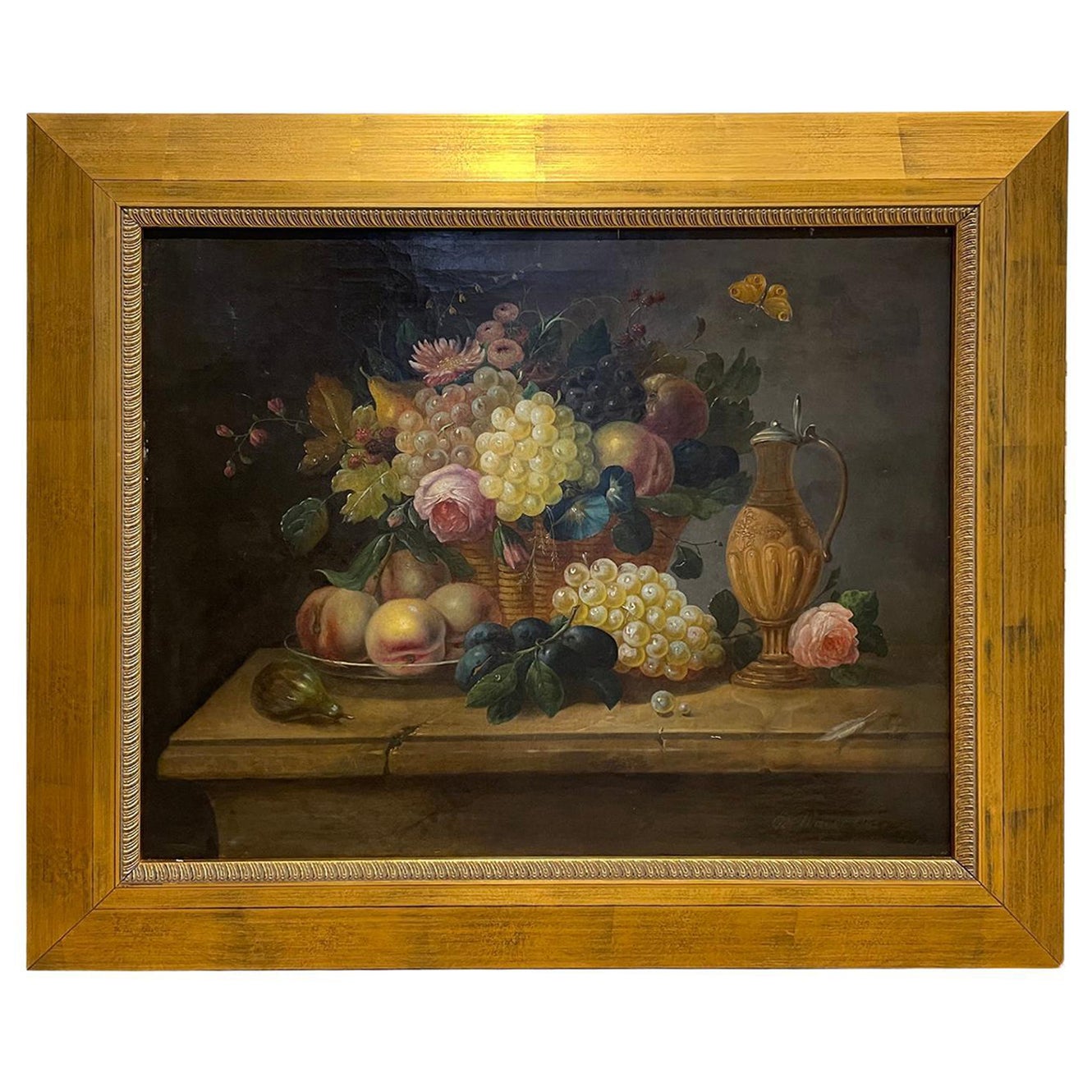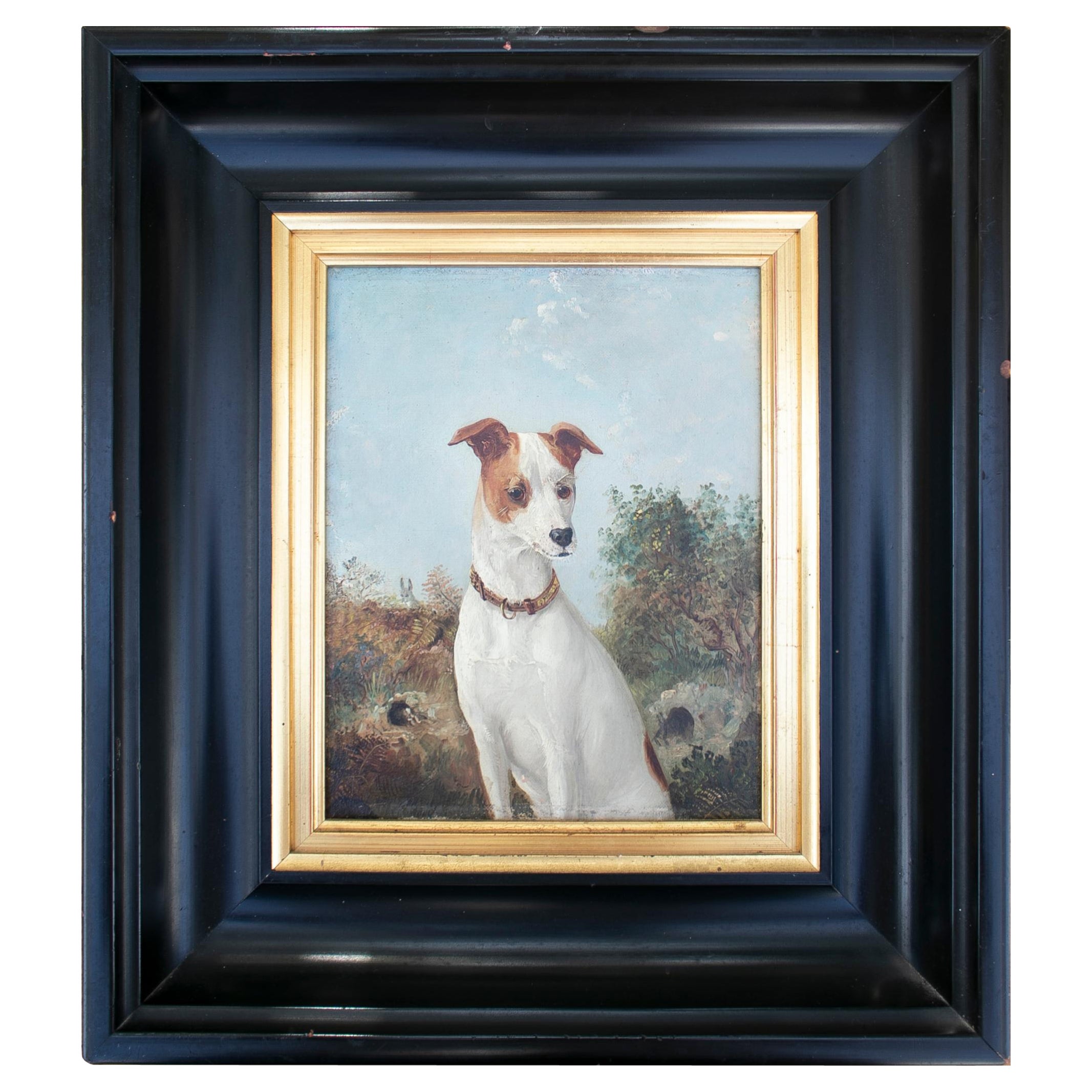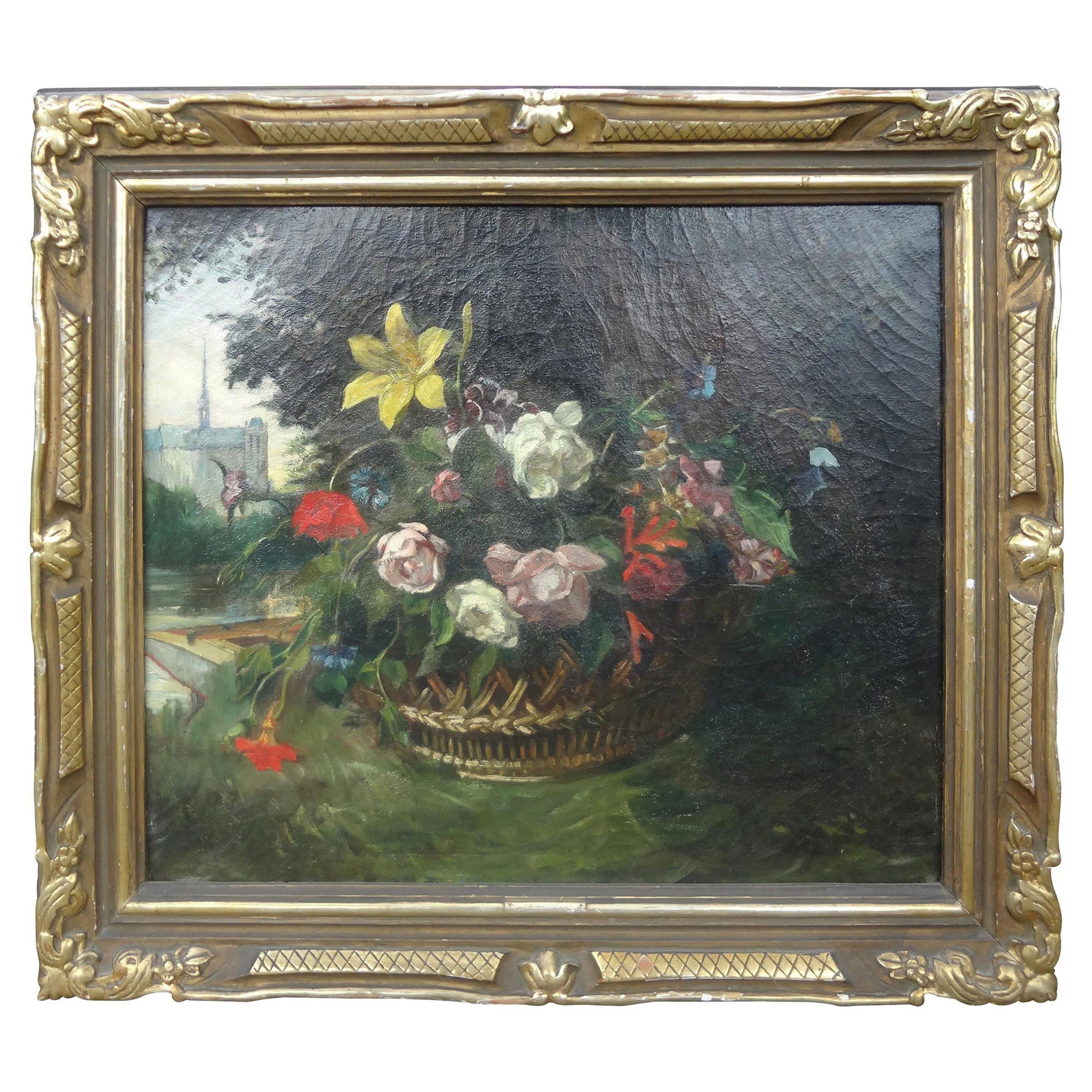Items Similar to 19th Century English Oil Painting with Flowers by John William Waterhouse
Want more images or videos?
Request additional images or videos from the seller
1 of 5
19th Century English Oil Painting with Flowers by John William Waterhouse
About the Item
A black-red, antique English school, still life oil on canvas painting depicting a basket with many colorful roses, flowers painted by John William Waterhouse in a hand carved, original gilded wood frame, in good condition. The colorful painting depicts a working table in a dim room, representing the 19th Century Impressionism art movement, period. Signed J.W. Waterhouse on the lower left. Wear consistent with age and use. Circa 1870 - 1890, London, England.
Without the frame: 19.5" H x 23.5" W x 1" D
John William Waterhouse was an English painter and a Pre-Raphaelite Brotherhood, later known as Pre-Raphaelites born in 1849, in Rome Italy and passed away in 1917, in London, England. He lived most of his life in London, known for his Academic Art or Academicism style ( painting and sculpture compounded under the influence of European Academies of Art - influenced by benchmarks of the French Académie des Beaux-Arts which was practiced under the two art movements Neoclassicism and Romanticism ). Waterhouse started to study at The Royal Academy of Arts, in London. Many of his paintings are based on authors such as the Roman poet Ovid and the English poets William Shakespeare and Alfred Tennyson. During his life time he painted 118 paintings.
Pre-Raphaelites was a group of English painters, artists, poets and art critics founded in 1848 by William Holman Hunt, John Everett Millais, Dante Gabriel Rossetti, William Michael Rossetti, James Collinson, Frederic George Stephens and Thomas Woolner who created a seven-member Brotherhood. The principles were intentional no-dogmatic, influenced by Romanticism.
- Creator:John William Waterhouse (Painter)
- Dimensions:Height: 32 in (81.28 cm)Width: 36 in (91.44 cm)Depth: 2.5 in (6.35 cm)
- Materials and Techniques:
- Place of Origin:
- Period:
- Date of Manufacture:circa 1870-1890
- Condition:Wear consistent with age and use.
- Seller Location:West Palm Beach, FL
- Reference Number:1stDibs: LU1622232255952
About the Seller
5.0
Vetted Seller
These experienced sellers undergo a comprehensive evaluation by our team of in-house experts.
Established in 1998
1stDibs seller since 2015
252 sales on 1stDibs
Typical response time: 2 hours
More From This SellerView All
- 19th Century Austrian Still Life Oil Painting with Flowers by Eduard WugerBy Eduard WugerLocated in West Palm Beach, FLA light-grey, black oil on canvas painting with flowers and fruits, painted by Eduard Wuger in good condition. The colorful antique Austrian painting depicts a round braided basket with many fruits, standing on a wooden working table...Category
Mid-20th Century Austrian Decorative Art
MaterialsCanvas
- 19th Century French Still Life Oil Painting of Flowers by Eugène Henri CauchoisBy Eugene Henri CauchoisLocated in West Palm Beach, FLA pink-white, antique French still life oil on canvas painting depicting a working table with a yellow teapot vase with flowers, painted by Eugène Henri ...Category
Antique Late 19th Century French Decorative Art
MaterialsCanvas, Giltwood
- 20th Century German Still Life Oil Painting with Flowers by Wilhelm KricheldorffBy Friedrich Wilhelm KricheldorffLocated in West Palm Beach, FLA light-yellow, green antique German oil on canvas painting, portraying a sunny day in a breakfast room with red, white flowers in a vase, painted by Wilhelm Kricheldorff in good con...Category
Late 20th Century German Decorative Art
MaterialsCanvas, Wood
- 20th Century Austrian Still Life Oil Painting with Flowers by Franz Xaver PielerBy Franz Xaver PielerLocated in West Palm Beach, FLA black-yellow, dark green antique Austrian still life oil on canvas painting depicting a clear glass vase with many flowers painted by Franz Xaver Pieler in a hand carved, original gilded wood frame, in good condition. The colorful painting depicts a dining table in a DIM room, representing the 19th...Category
Early 20th Century Austrian Decorative Art
MaterialsCanvas, Wood, Giltwood
- 19th Century French Still Life Oil on Canvas Painting by Dominique Hubert RozierBy Dominique Hubert RozierLocated in West Palm Beach, FLA pink-yellow, antique French still life oil on canvas painting, depicting a white ceramic vase with many roses, painted by Dominique Hubert Rozier in a handcrafted, original gilded ...Category
Antique Late 19th Century French Decorative Art
MaterialsCanvas, Giltwood
- 19th Century French Still Life Oil Painting of Roses by Eugène Henri CauchoisBy Eugene Henri CauchoisLocated in West Palm Beach, FLA red-yellow, antique French still life oil on canvas painting depicting a working table with a dark-blue vase with flowers, painted by Eugène Henri Cauchois in a hand carved, origin...Category
Antique Late 19th Century French Decorative Art
MaterialsCanvas, Giltwood
You May Also Like
- Large Oil Painting of A Gentleman. English, Late 19th CenturyLocated in St Annes, LancashireGreat portrait painting. Wonderful quality to the face. Artist and sitter both unknown Possibly a Scottish laird? Oil on canvas. Canvas re-lined Unframed.Category
Antique Late 19th Century English Victorian Paintings
MaterialsWood
- English Oil on Canvas Still Life of Flowers Framed, 19th CenturyLocated in Cypress, CAAttractive late 19th century English oil on canvas still life of chrysanthemums in unique giltwood frame Meticulous attention given to detail Another similarly framed still life...Category
Antique Late 19th Century English Paintings
MaterialsGiltwood, Paint
- 19th Century English Oil on Canvas Hunting Dog Portrait Painting w/ FrameLocated in Marbella, ESAntique 19th century English oil on canvas hunting dog portrait painting with black and giltwood frame. Dimensions including frame: 43 x 38 x 8cm.Category
Antique 19th Century English Paintings
MaterialsCanvas
- 19th Century French Framed Floral Oil PaintingLocated in Houston, TX19th century French framed floral oil painting. Stunning 19th century French framed oil on canvas painting. This gorgeous well executed Barbi...Category
Antique 1860s French Barbizon School Paintings
MaterialsCanvas, Giltwood, Paint
- John Thomas Serres, Fine Harbour Painting, Signed, 19th CenturyBy John Thomas SerresLocated in Aalsgaarde, DKJohn Thomas Serres (1757-1825) painting of fine harbour, signed "J.T. Serres". Oil on wood, 19th century. Measures: H 43, W 51 cm. H 16.9, W 20 in.Category
Antique Early 1800s European Paintings
- California Oil on Canvas Painting, 19th CenturyLocated in Cypress, CACalifornia oil on canvas landscape painting, "Evening Glow" - Otto Robert Gaensslen (1876-1915; American) Late 19th-early 20th century. Artist Bio: ...Category
Antique Late 19th Century American Paintings
MaterialsCanvas
Recently Viewed
View AllMore Ways To Browse
Wall Art Canvas Flower
Roman And William
Stephen Walling Artist
Late 19th Century Carved English Table
English Hunt
Italian Antique Wall Sculpture
English Arts Crafts Table
English Arts And Crafts Table
19th Romanticism
Antique School Art Table
Original Wall Art Reds Blacks Framed
French Hunt Carved
Roman Thomas Furniture
Roman Thomas
Antique Wood Carved Roses
Antique French Neoclassical Style Painted
Antique Rose On Canvas
Carved Wood Basket Of Flowers
